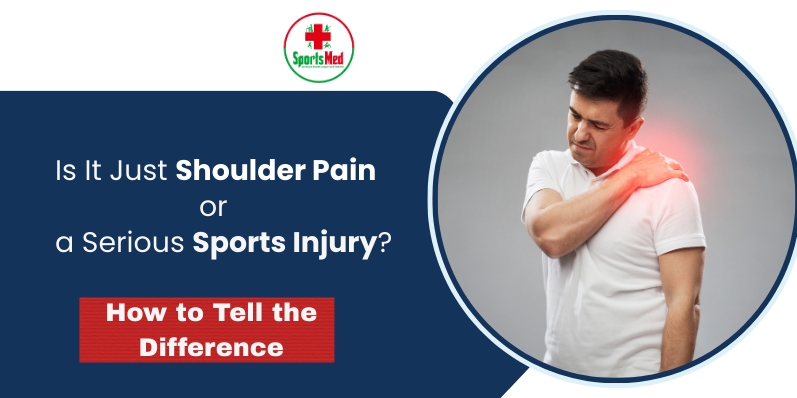
Is It Just Shoulder Pain or a Serious Sports Injury? How to Tell the Difference
Shoulder pain is a common complaint among athletes, and it’s easy to brush it off as just a minor discomfort. But for athletes, what might seem like ordinary shoulder pain could actually be the sign of a more serious injury. Knowing when to push through discomfort and when to seek professional help is crucial for ensuring you don't make an injury worse. In this blog, we’ll help you distinguish between typical shoulder pain and more serious injuries and guide you on when it’s time to seek medical attention.
Common Causes of Shoulder Pain in Athletes
Before diving into how to tell the difference between typical pain and a serious injury, it’s important to understand the common causes of shoulder pain in athletes:
-
Overuse: Repetitive overhead motions, such as those in tennis, baseball, or swimming, can lead to conditions like rotator cuff tendinitis.
-
Injury: Falls, direct hits, or awkward landings in sports can result in strains, sprains, or tears in the shoulder muscles or ligaments.
-
Impingement: When the tendons of the rotator cuff become pinched during movement, it can lead to sharp pain.
-
Labral Tears: Damage to the cartilage that lines the shoulder joint can result in pain and instability.
-
Fractures: A direct blow to the shoulder could lead to a fracture in the collarbone or the bones of the shoulder joint.
Is It Just Shoulder Pain? Here’s How to Tell the Difference
1. Type of Pain
-
Mild, Dull Ache: A dull, lingering ache is often a sign of overuse or muscle fatigue, and it may resolve with rest or stretching. It could be caused by something like muscle tightness or minor strain.
-
Sharp, Intense Pain: If the pain is sharp and sudden, especially during specific movements (like throwing, lifting, or overhead motions), it may indicate a ligament or tendon injury or even a tear. This type of pain should be monitored closely.
-
Pain with Specific Movements: If the pain occurs primarily during specific activities—like overhead movements, reaching, or lifting weights—this may point to rotator cuff issues, tendinitis, or impingement syndrome. If the pain is persistent and doesn’t improve with rest, this could indicate a more serious injury.
2. Range of Motion
-
Normal Range of Motion: If you can move your shoulder without restriction but feel some discomfort, it may simply be muscle fatigue or mild strain.
-
Limited Range of Motion: If you’re unable to fully rotate or lift your arm without significant pain, it could be a sign of a more serious injury, such as a rotator cuff tear, labral tear, or shoulder dislocation.
3. Swelling and Bruising
-
Minor Swelling: Mild swelling after an intense workout or training session could be due to muscle inflammation, which typically subsides with rest and ice.
-
Significant Swelling or Bruising: Large amounts of swelling, especially if accompanied by bruising, could indicate a tear or fracture in the shoulder joint. Immediate medical attention is needed in such cases.
4. Instability
-
No Instability: If your shoulder feels stable and you can continue using it with only mild pain, this is a good sign that the injury is likely not serious.
-
Feeling of Instability: If your shoulder feels like it might “give out” or you experience a sensation of weakness or “looseness,” it could be a sign of a more severe injury, such as a shoulder dislocation or a labral tear. Instability should not be ignored, as it could affect your performance and lead to further injury.
5. Duration of Pain
-
Temporary Pain: If the pain comes and goes but improves with rest, ice, or stretching, it’s often a sign of muscle strain or mild tendon irritation.
-
Persistent or Worsening Pain: If the pain continues for several days without improvement or worsens over time, it may indicate a more serious injury, such as a torn ligament, rotator cuff injury, or labral tear. This is a signal that professional evaluation is necessary.
6. Numbness or Tingling
-
No Numbness: If you don’t experience numbness or tingling, the issue is likely isolated to muscle or tendon pain.
-
Numbness/Tingling: If you feel numbness or tingling in your arm or hand along with shoulder pain, it could indicate nerve involvement, often caused by a herniated disc in the neck or a severe shoulder injury. This requires immediate attention.
When Should You Seek Medical Attention?
Not all shoulder pain requires a trip to the doctor, but if any of the following apply to your situation, it’s time to get evaluated:
-
Severe or Sudden Pain: If you experience intense pain, especially after an injury, it’s important to seek medical attention right away.
-
Inability to Move the Shoulder: If you can’t move your shoulder normally or there is a noticeable loss of range of motion, it’s time to consult with a doctor.
-
Swelling, Bruising, or Deformity: If there is significant swelling, bruising, or deformity in the shoulder, it could indicate a serious injury like a fracture or dislocation.
-
Instability or Weakness: A feeling of instability or weakness in the shoulder that doesn’t improve with rest requires professional assessment to prevent further damage.
-
Persistent Pain: If the pain lingers for more than a few days and doesn’t improve with rest, it’s time to seek help from a healthcare professional.
Conclusion
Shoulder pain can range from mild discomfort to a sign of a serious sports injury, so it’s crucial to listen to your body and know when to seek medical attention. If you experience sharp pain, limited movement, swelling, instability, or persistent discomfort, it’s important to get evaluated by a doctor. Early intervention can help prevent further damage and set you on the right path to recovery, allowing you to return to your sport stronger and safer than before.